You know that feeling when the plane starts descending and suddenly your stomach does this weird flip? Not from turbulence. From realizing you’ve been pronouncing the city name wrong for weeks.
“Buda-PESHT,” the flight attendant said over the intercom. PESHT. Not pest like an annoying bug. I’d been telling everyone I was going to Buda-pest for a month.
3:47 PM, wheels touched down. Airways got me there in one piece, which honestly after that sketchy takeoff from London where we definitely almost clipped another plane (the pilot would disagree, but I saw what I saw), felt like a minor miracle. The Hungarian countryside spread out below looked like someone had taken a ruler to farmland – everything in perfect rectangles of green and gold. So different from the chaotic sprawl I’d just left behind.
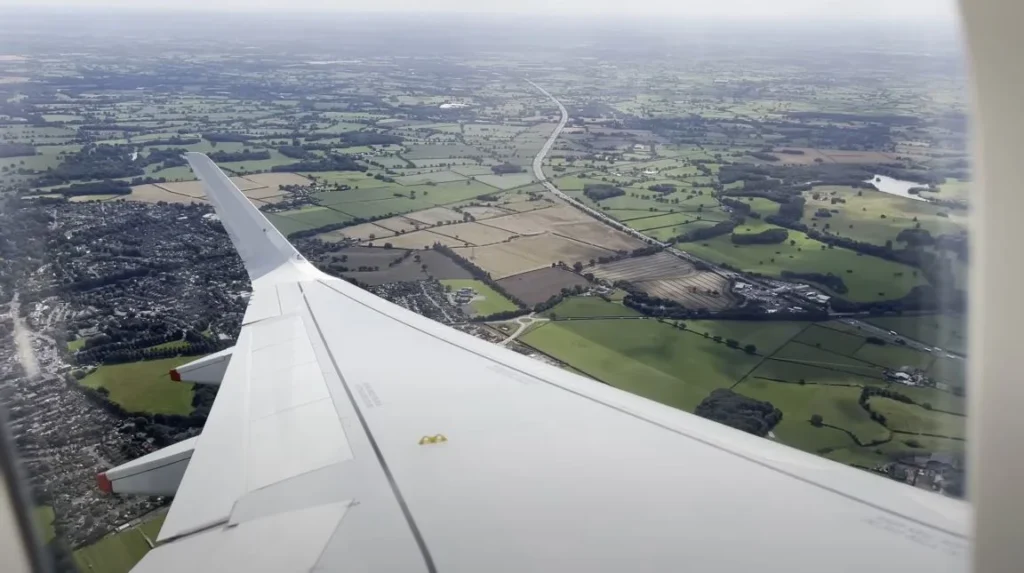
Here’s what nobody tells you about landing in Budapest: the airport is far. Like, stupidly far from anything resembling the city. 23 kilometers of nothing but IKEA billboards and communist-era apartment blocks that look like they’re having an existential crisis.
The taxi driver – László, who had exactly three English phrases: “Welcome Budapest,” “Very nice,” and “Fifty euros please” – drove like he was personally offended by the concept of speed limits. We hit 140 km/h on a road that definitely wasn’t meant for it. I white-knuckled my phone the entire ride, pretending to text while actually checking if my travel insurance covered death by taxi.
But then.
Then you round this bend on the highway and BAM. The Danube appears. And rising from it like something out of a fever dream is this city that can’t decide if it wants to be Vienna, Paris or it’s own magnificent mess.
My First 48 Hours of Getting Everything Wrong
The Bridge Incident
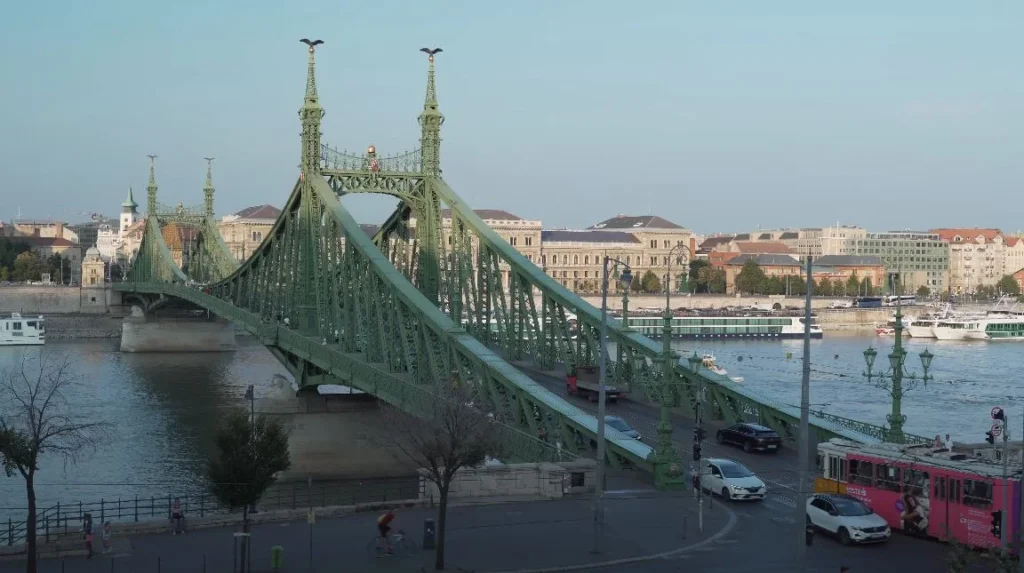
Liberty Bridge. Szabadság híd. That green Art Nouveau beauty that every Instagram influencer has posed on. I thought I’d be clever and catch it at sunrise my first morning. 5 AM alarm. Walked forty minutes from my Airbnb in Pest (yes, the flat side) only to discover sunrise happens BEHIND the bridge from that angle, not over it.
So there I was, exhausted, watching the world’s most underwhelming silhouette while a homeless guy on a bench nearby laughed at me. Actually laughed. Then offered me a swig from his bottle which, at 5:45 AM after that walk, I genuinely considered.
The bridge though? Even backlit wrong, it’s something else. Those turuls – the mythical Hungarian birds perched on top – look ready to fly off and attack anyone who disrespects their city. The green ironwork isn’t just green; it’s this specific shade that changes from mint to emerald depending on how the light hits it.
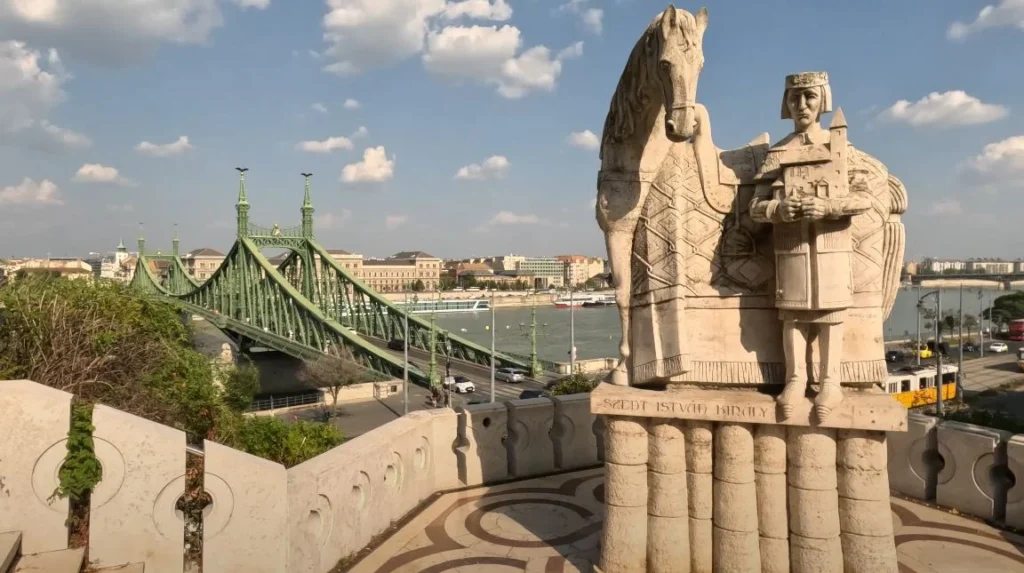
I came back later that evening (from the correct side this time) and watched the sun set over the Danube. A different homeless guy was there. Different bench. Same laughter when I told him about my morning fail. Budapest homeless people are apparently a unified network of tourist-mocking professionals.
Yellow Buildings and Existential Taxi Rides
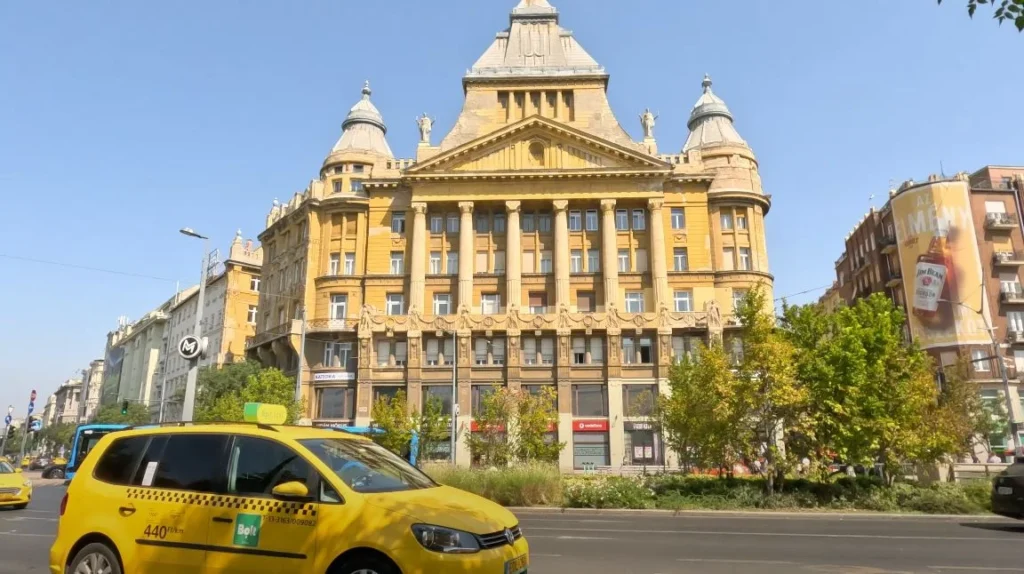
Every corner in District V slaps you with another yellow building that makes you question everything you thought you knew about architecture. This isn’t the gentle cream of Vienna or the pristine white of Paris. Budapest went full egg-yolk yellow and committed to it hard.
The Anker Palace – that beast in the photo with the taxi – used to be an insurance company headquarters. Now it’s got a Burger King on the ground floor. I mean, if that doesn’t sum up post-communist capitalism, what does? The facade is this insane mix of Art Nouveau and “we have too much money” energy. Cherubs, flowers, geometric patterns and then boom – “Have it Your Way” in Hungarian.
Those yellow Bolt taxis are everywhere. 440 forint base fare (about €1.10), which seems reasonable until you realize the drivers interpret traffic laws as gentle suggestions. My second ride, the driver went THE WRONG WAY down a one-way street for three blocks because “Is faster, yes?“
Yes, Gábor. Yes it was faster. Also terrifying.
The Breakfast Revelation
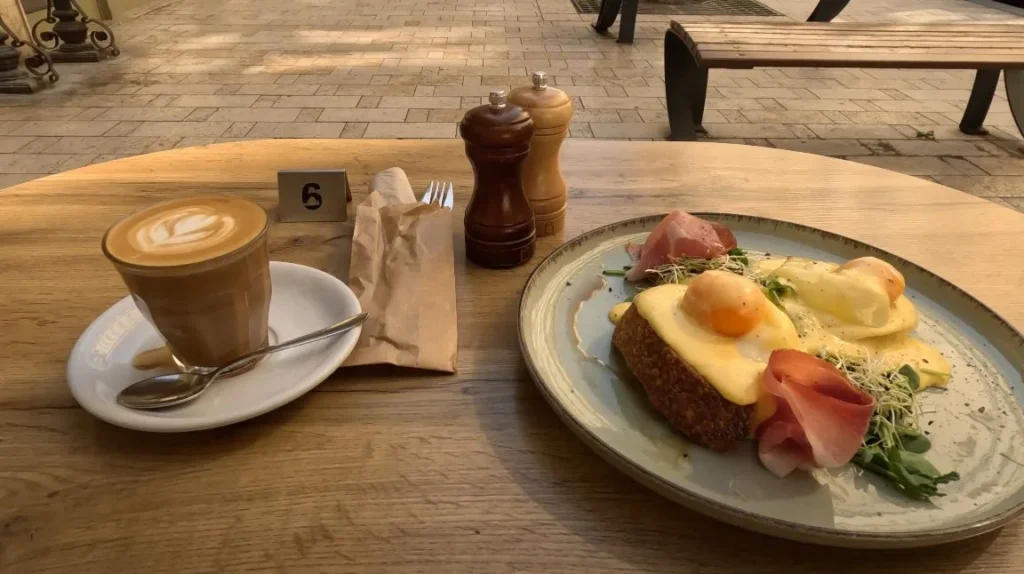
Day two. Found this hole-in-the-wall café that didn’t even have a name, just a faded sign that might have said “Kávé” once upon a time. The kind of place where the owner looks personally offended when you try to order in English.
That breakfast though. 2,800 forint (about €7) for what you see in that photo. The bread wasn’t just bread – it was this dense, seeded situation that could double as a weapon. The ham wasn’t some sad deli nonsense but actual carved-off-the-leg glory. And that egg? Runny enough to make the whole plate a beautiful mess.
The coffee deserves it’s own paragraph. Or thesis. Hungarian coffee doesn’t mess around. It’s not trying to be your friend. It’s there to slap you awake and question your life choices. Three sugars couldn’t tame it. The locals drink it black, staring into the middle distance like they’re solving complex mathematics or remembering the Austro-Hungarian Empire.
The Streets That Eat Your Soul
Getting Lost as a Sport
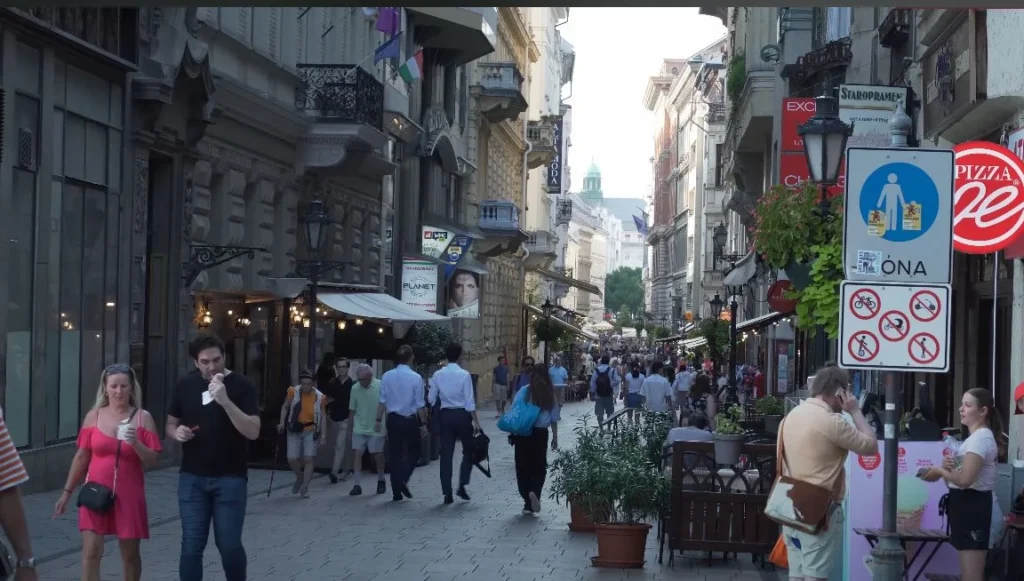
District V’s pedestrian streets are a maze designed by someone who hates tourists. Or loves them, depending on how you interpret the endless loops that somehow always lead back to that same H&M.
Váci utca is the main drag – the one all the guides tell you to visit. It’s also a hellscape of overpriced chimney cakes (kürtőskalács, if you’re trying to impress someone) and people trying to sell you boat tours that are definitely not worth 35 euros. But step one street over? Suddenly you’re in actual Budapest, where people live and work and argue about football.
I watched two old men have a twenty-minute screaming match about something involving either the 1954 World Cup or their wives. My Hungarian extends to “hello,” “thank you,” and “more wine please,” so the specifics escaped me. But the passion? Universal.
Market Madness
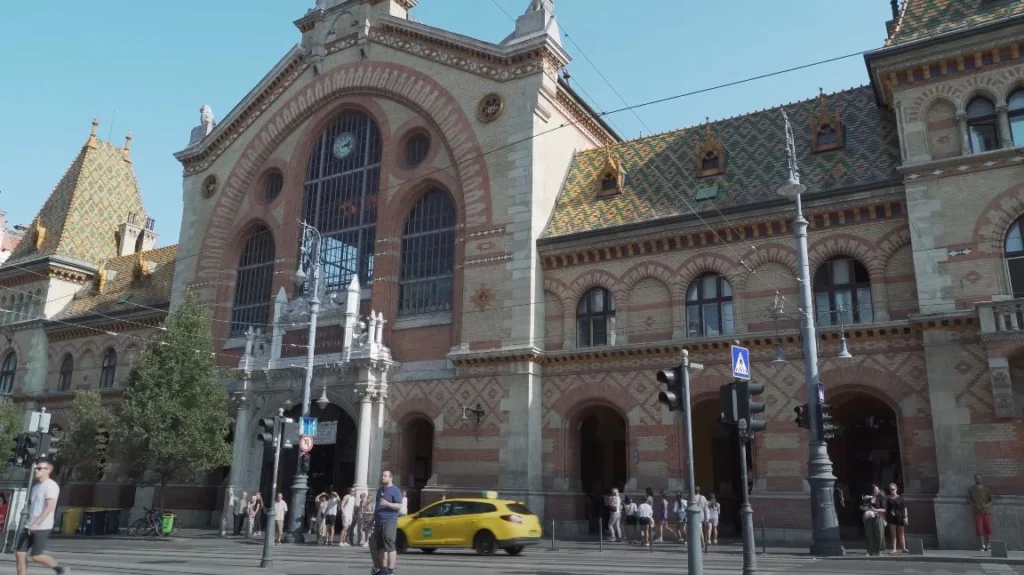
The Central Market Hall. Nagy Vásárcsarnok. That roof alone – those colored Zsolnay tiles that look like dragon scales – should charge admission just to be looked at.
Inside is organized chaos. Ground floor: paprika in every possible iteration. Paprika paste, paprika powder, smoked paprika, sweet paprika, “will burn your face off” paprika. I bought six different types because the vendor kept giving me samples and I felt guilty. My bag still smells like a Hungarian grandmother’s kitchen.
Upper floor: tourist trap central. Embroidered everything. Matryoshka dolls that have nothing to do with Hungary but whatever, tourists buy them. Lace that your great-aunt would love. I bought a tablecloth I’ll never use for 18,000 forint because the lady selling it reminded me of my mom and guilt is apparently my primary shopping motivation.
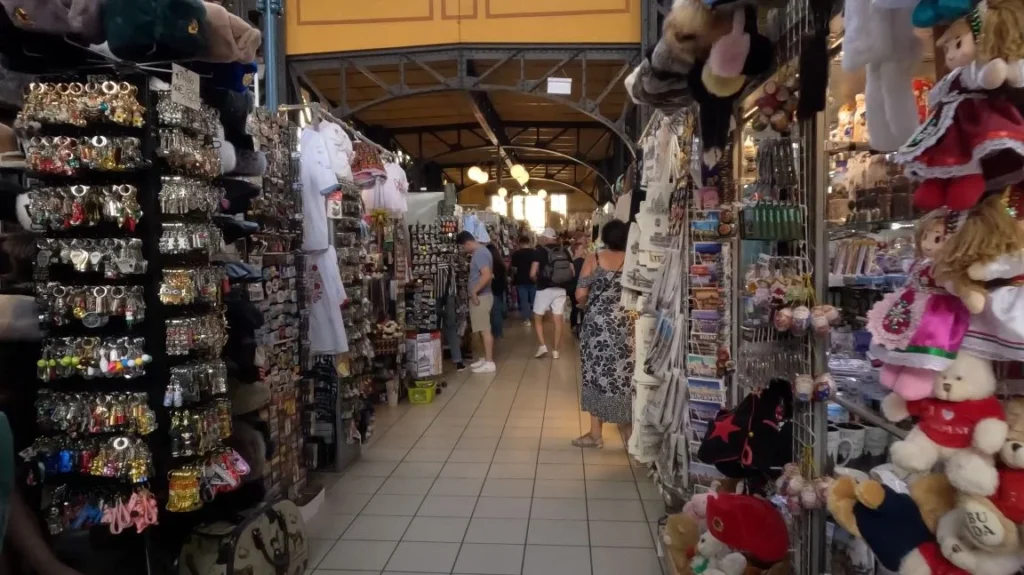
But the basement. The basement is where things get real. Pickled everything. Fish that look like they’re planning revenge. Butchers who treat their meat like art. I watched a guy carve a pig for fifteen minutes. It was meditative. Also slightly disturbing. But mostly meditative.
The Cafe Culture That Ruins You
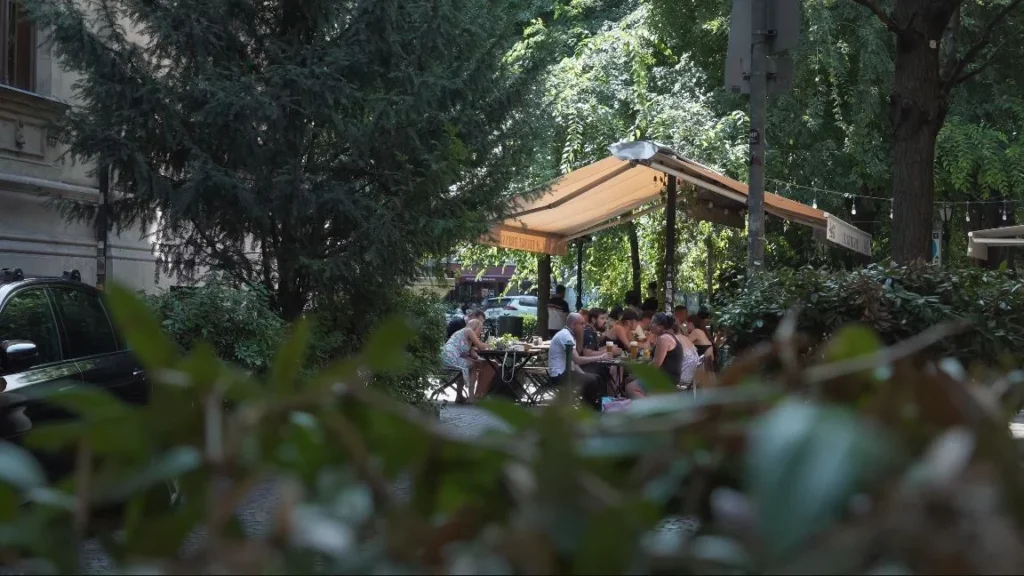
Found this spot tucked away near Károlyi Garden. No tourists. Just locals arguing about politics over tiny cups of brutal coffee and chain-smoking like it’s 1987.
Budapest cafe culture isn’t Parisian. It’s not trying to be pretty for your Instagram. These places exist for conversations that last four hours and solve nothing. For chess games between old men who haven’t spoken in years except to say “check.” For students pretending to study while actually planning the revolution or their next Tinder date.
I sat there for three hours. Ordered four coffees. Wrote nothing in my journal. Just listened to the Hungarian flowing around me like water I’d never learn to swim in. The waiter kept refilling my water glass without asking, which is apparently Hungarian for “you’re okay, you can stay.”
The Water Cult and Why Hungarians Are Basically Fish People
Let me tell you about Hungarian thermal baths. Actually, no. Let me tell you about the specific hell that is Széchenyi Thermal Bath on a Saturday.
Picture this: 3,800 forint to enter what’s essentially a human soup kitchen. The baroque building is gorgeous, sure. Yellow walls (because Budapest has a thing), outdoor pools that steam like witches’ cauldrons, chess players who’ve been sitting in 38°C water so long they’ve partially dissolved.
I went at 10 AM thinking I’d beat the crowds. Rookie mistake. Hungarians don’t sleep on weekends; they marinate. The changing room was a war zone of naked bodies and aggressive locker-slamming. A 70-year-old woman shoved me aside to get to her locker, muttering something that was definitely a curse. Her swimming cap had cats on it. Respect.
The water hits different when it’s literally coming from 1,256 meters underground. Not metaphorically different. Actually, chemically, physically different. It smells like eggs that gave up on life. Sulfur, they call it. Death, I call it. But after ten minutes? You stop caring. After twenty? You understand why half of Budapest spends their weekends here playing chess while their skin prunes into oblivion.
There’s this unspoken protocol nobody tells you about. The old men have their corner where they discuss what I assume is either politics or their prostates. The Russians (always Russians) have colonized the hottest pool. The locals float in the middle pool with a determination that suggests this is medical, not recreational.
I lasted two hours. Would’ve stayed longer but a man with a handlebar mustache started explaining the Habsburg Empire to me in broken English and I couldn’t tell if he was hitting on me or genuinely thought I needed a history lesson. Both, probably.
Keleti Station and the Art of Hungarian Chaos
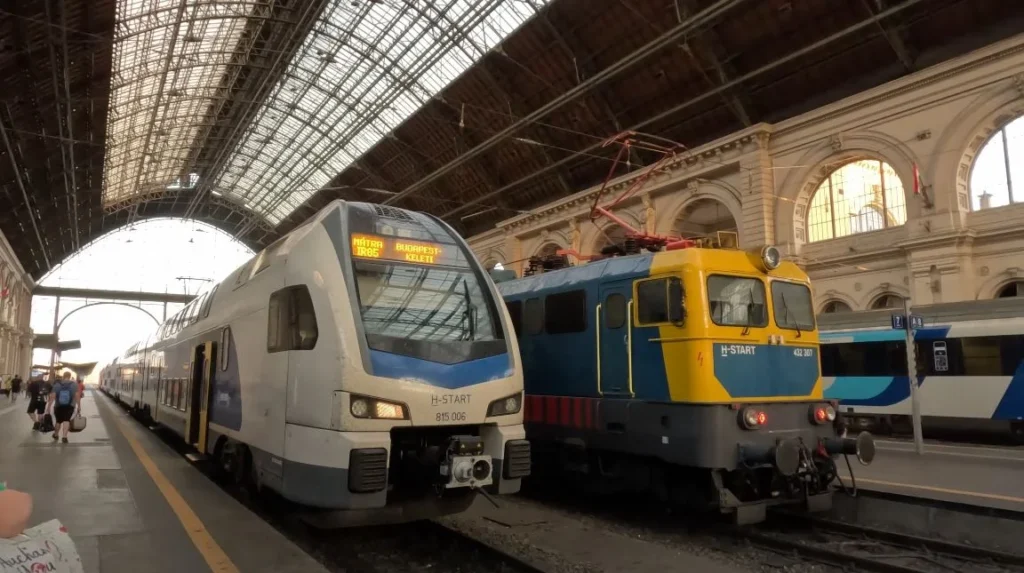
Keleti pályaudvar. Eastern Railway Station. Where dreams go to get delayed indefinitely.
That gorgeous facade hides absolute mayhem. Built in 1884 when train travel was glamorous and people wore hats unironically. Now it’s where you go to question all your life choices while waiting for the 14:37 to Vienna that’s somehow already forty minutes late at 14:00.
I needed to get to Lake Balaton. Simple enough, right?
Wrong.
The ticket office is staffed by women who’ve perfected the art of making you feel stupid in twelve languages. Mine spoke exactly zero English but communicated purely through disapproving nostril flares and aggressive stamp-slamming. 6,200 forint later, I had a ticket to somewhere. Hopefully Balaton. Possibly Bulgaria.
The departure board is in Hungarian only. Because why would Hungary’s largest international train station cater to international travelers? That would make sense and making sense is apparently illegal here.
Platform 6. Track 6. Vágány 6. Same thing? Different thing? Nobody knows. I asked three different people and got three different answers, two shrugs and one man who just walked away mid-question.
The train itself – that yellow and blue beast in the photo – looked like it escaped from a transportation museum. The seats were that specific communist red that exists nowhere in nature. The windows opened exactly 4 centimeters, enough to tease you with fresh air but not enough to actually breathe.
But here’s the thing: it worked. Rattled and shook like it was auditioning for a massage chair commercial, but it got me there. Through countryside that looked like Windows XP wallpaper. Past stations with names I couldn’t pronounce if you paid me.
The conductor was this tiny woman who could’ve been anywhere from 45 to 75 years old. She punched my ticket with such violence I thought she was trying to kill it. Then smiled and said something that was either “enjoy your journey” or “your ticket is wrong and you’ll be arrested.” Hungarian is ambiguous like that.
Architecture Wars: When Baroque Meets What-The-Hell-Is-That
Church Roulette
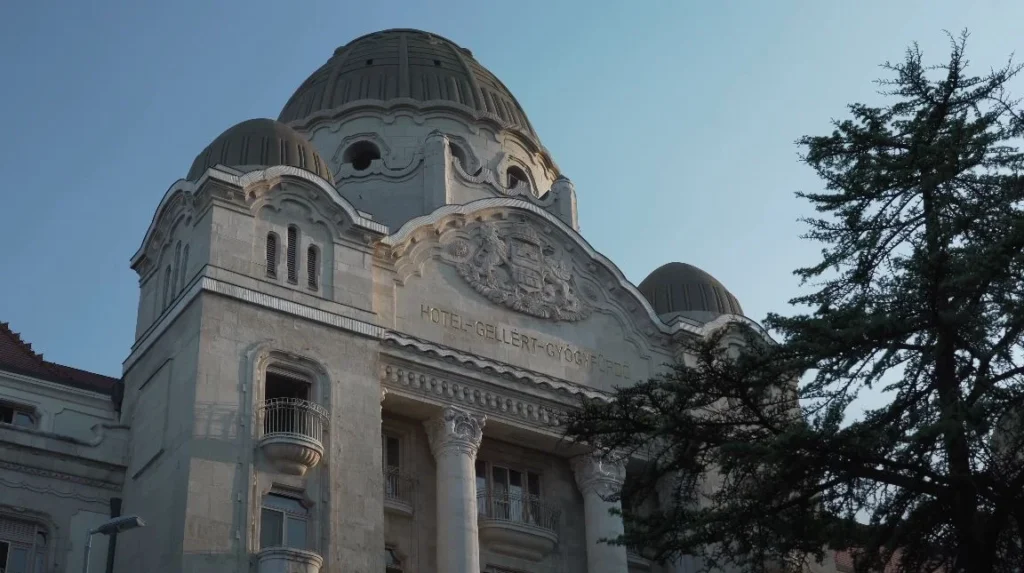
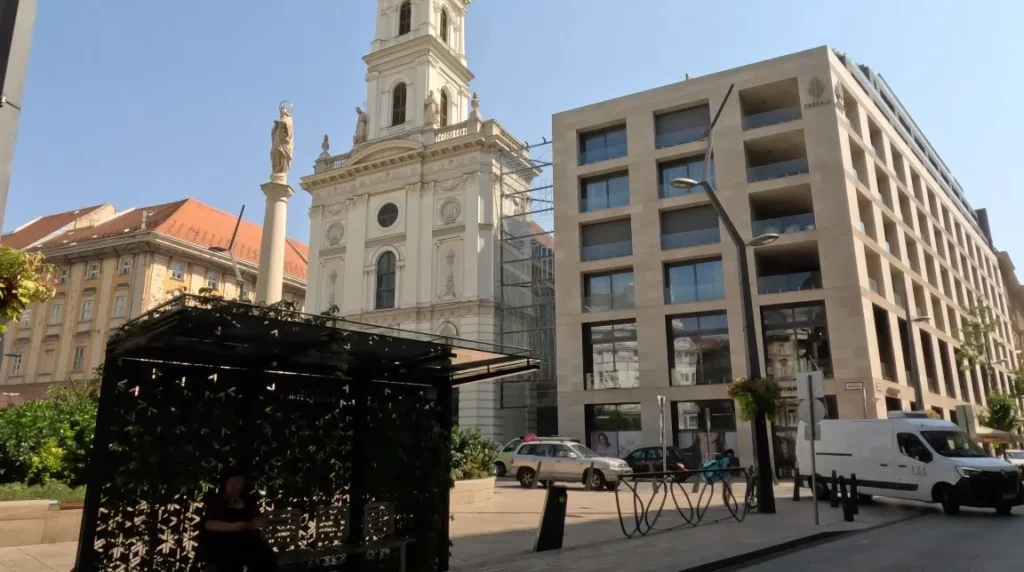
Budapest can’t decide what it wants to be architecturally and honestly? That’s the best part.
Take this synagogue – the Dohány Street one, though there are like seventeen that look similar because Budapest’s Jewish Quarter doesn’t do anything halfway. Moorish Revival architecture in the middle of Europe. Makes total sense if you don’t think about it.
The facade has this “Hotel Gellért and a mosque had a baby” energy. Those onion domes aren’t trying to fit in. They’re basically giving the finger to every baroque church in a three-kilometer radius. Inside (7,500 forint to enter, because Judaism isn’t free), it’s even more confused. Organ music in a synagogue? Sure. Christian architectural elements? Why not. A weeping willow sculpture in the courtyard made of metal that’ll make you cry? Absolutely.
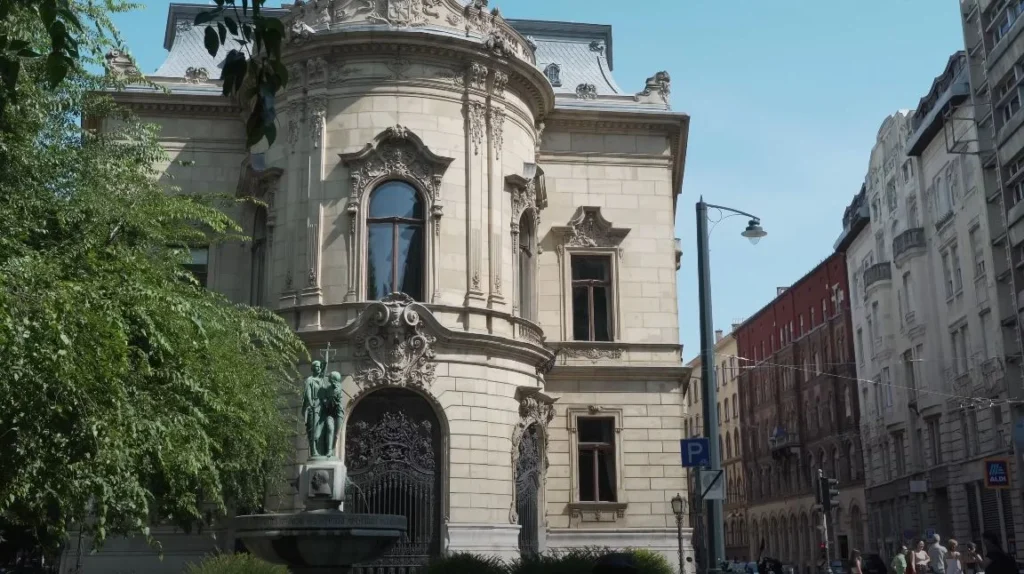
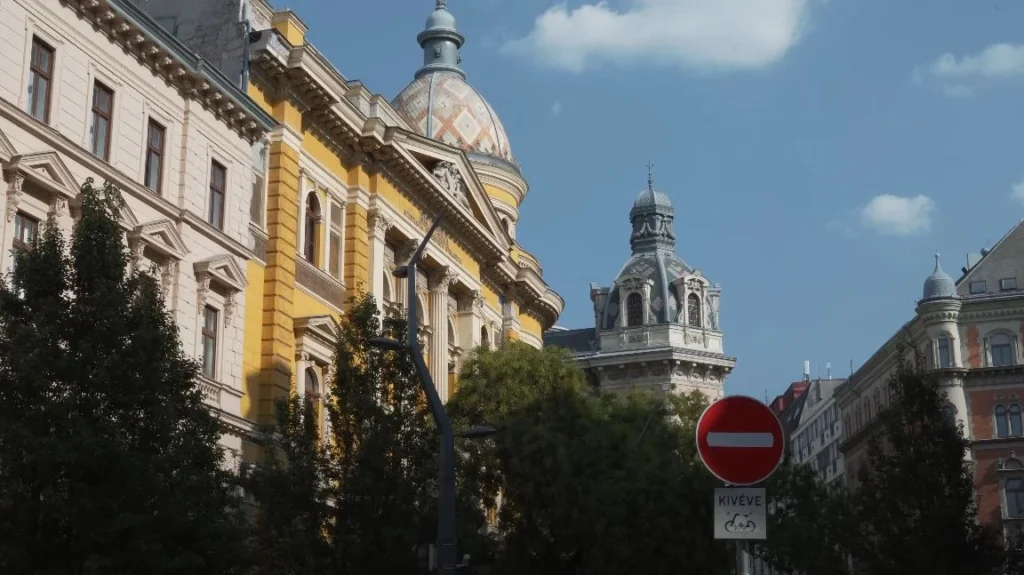
Then you walk two blocks and BAM – another church that looks like it was designed by someone who’d only had churches described to them by a drunk person. Baroque? Yes. Makes sense? No. That dome in the photo has a hole in it that nobody can explain. Not war damage. Not renovation. Just… a hole. “Is for ventilation,” the guard told me. For God? Does God need ventilation?
The yellow church (because of course it’s yellow) has this painted dome that changes colors depending on where the sun is. Not intentionally. The paint is just old and weird and possibly toxic. But at 5 PM it turns this insane pink-orange that makes you stop walking and just stare like an idiot tourist. Which I was. Am. Whatever.
The Modern Situation
Between all these historical monuments, Budapest squeezed in some modern buildings that look like they’re apologizing for existing. Glass and steel trying not to make eye contact with the baroque neighbors. That apartment building next to the church? It’s having an identity crisis. “Should I be fancy? Should I be practical? Should I just be storage for humans?” It chose all three and succeeded at none.
Ruin Bars: Drinking in Abandoned Buildings Is Apparently Culture Now
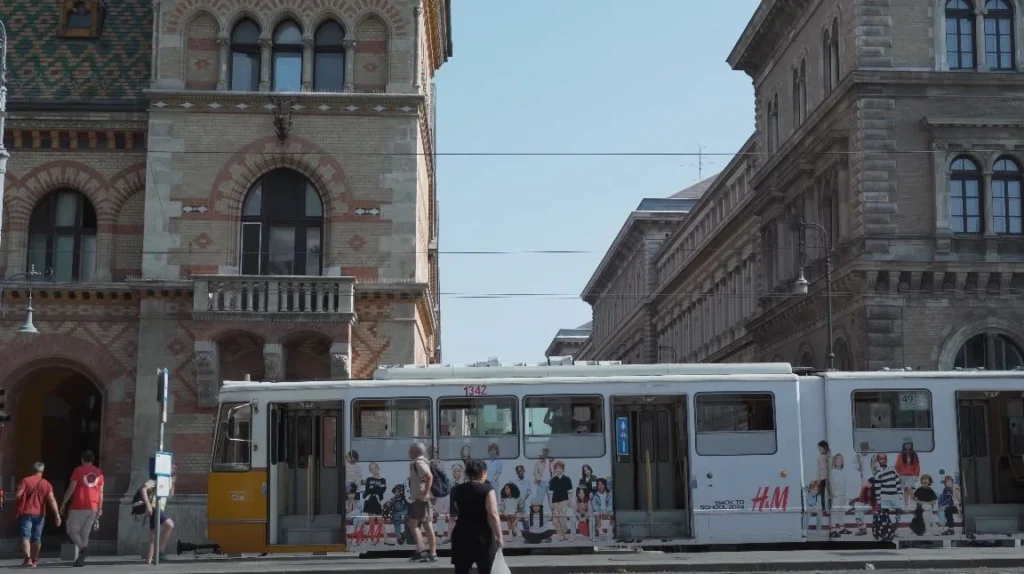
Szimpla Kert. If you haven’t been, you haven’t “done” Budapest, according to every blog, guidebook and drunk British bachelor party I encountered.
It’s in an old factory. Or apartment building. Or possibly both. Nobody’s really sure anymore. What matters is that someone looked at this condemned structure and thought, “You know what this needs? A bar. Actually, six bars. And a food truck in the courtyard. And mannequins hanging from the ceiling. And a car. Inside. For sitting.”
Entry is free, which should be your first warning. Drinks are not free. They’re actually expensive as hell. 1,800 forint for a beer that would cost 600 anywhere else. But you’re not paying for the beer. You’re paying for the experience of drinking surrounded by furniture that looks like it was rescued from a flood, graffiti that might be art or might be vandalism and tourists taking selfies with a bathtub full of plastic ducks.
The locals don’t really go to Szimpla anymore. They’ve moved on to places that don’t have TripAdvisor reviews. But at 2 AM on a Tuesday, when you’re six drinks in and someone’s playing an accordion badly in the corner, it doesn’t matter. You’re part of the chaos now.
Met a girl from Slovenia who was convinced she’d discovered the meaning of life in the bathroom graffiti. A guy from Newcastle who’d been there for three days straight. Not three nights. Days. The bartender knew his name and his usual (pálinka, because of course).
The trams run right by and after midnight they’re mostly empty except for other people leaving ruin bars. The yellow ones are older, from the ’60s. They shake like they’re about to fall apart but they don’t. Much like everyone on them at 3 AM.
Night Scenes and the Danube’s Split Personality
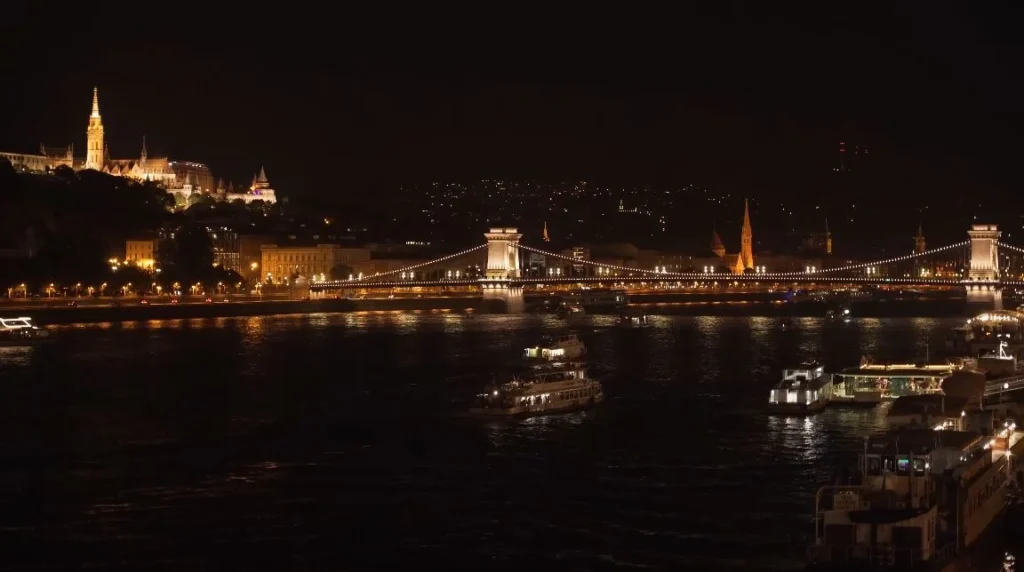
Here’s the thing about Budapest at night: it becomes a completely different city. Not metaphorically. Literally. The lights transform it into this golden hallucination where you can almost forget about the daytime chaos.
Chain Bridge lit up is a cliché for a reason. Those lights aren’t just illumination; they’re makeup for a city that knows how to work it’s angles. Buda Castle looming above like it’s judging your life choices. The parliament building across the river doing it’s best Parliament impression (it’s literally modeled after Westminster but bigger because Hungary doesn’t do subtle).
I did the river cruise. 4,500 forint for an hour of floating past buildings while a recorded voice tells you facts you’ll immediately forget. “This bridge was rebuilt after World War II.” They all were. “This building is important.” They all are. But with a plastic cup of wine that tastes like regret and the lights reflecting off the water? Magical. Touristy as hell, but magical.
The boats are packed with couples trying to be romantic while dodging selfie sticks. A woman dropped her phone in the Danube trying to get the perfect shot. Her husband laughed. She didn’t speak to him for the rest of the cruise. Budapest claims another relationship.
The Food Situation Nobody Warns You About
Goulash Is a Lie
Every menu. Every. Single. Menu. Has goulash. “Traditional Hungarian goulash!” they scream. It’s soup. Just soup. Sometimes good soup, usually average soup, occasionally soup that makes you question the Geneva Convention.
The best goulash I had was from a food truck at 3 AM outside Szimpla. 1,200 forint, served in a bread bowl that immediately disintegrated, turning the whole thing into a meat-bread-sauce situation that required eating with my hands like a barbarian. The vendor watched me struggle, said something in Hungarian that was definitely mockery and gave me extra napkins.
Lángos is the real hero food. Deep fried dough covered in sour cream and cheese. It’s a heart attack in food form. It’s also perfect. 800 forint from street vendors, 2,000 if you’re stupid enough to buy it on Váci utca. The grease soaks through three napkins. Your arteries scream. You order another one.
Restaurants That Don’t Want You There
Found this place in District VII. No sign. Just a door. Inside, six tables, one waiter who looked personally offended by my existence and the best food I’ve had in years.
The menu was entirely in Hungarian. Handwritten. Possibly in code. I pointed at something that looked pronounceable. What arrived was… I still don’t know. Meat, definitely. Some kind of sauce that tasted like paprika had a baby with cream and raised it in a cave. Dumplings that could’ve been used as building material.
3,200 forint total. The waiter softened slightly when I finished everything, even the pickled vegetables that tasted like punishment. “Good?” he asked, his first English word. “Good,” I confirmed. He almost smiled. Almost.
The Market Food Underground
Below the Central Market Hall, past the tourist level, past the pickle basement, there’s this section where actual Budapest residents buy actual food. Followed a grandmother down there because she looked like she knew things.
She did.
Bought blood sausage that looked like a crime scene. Cheese that smelled like feet but tasted like heaven. Bread that could survive nuclear war. The vendor spoke exactly three words of English: “No,” “Cash,” and inexplicably, “Tuesday.”
The Urban Decay Tourism Nobody Talks About
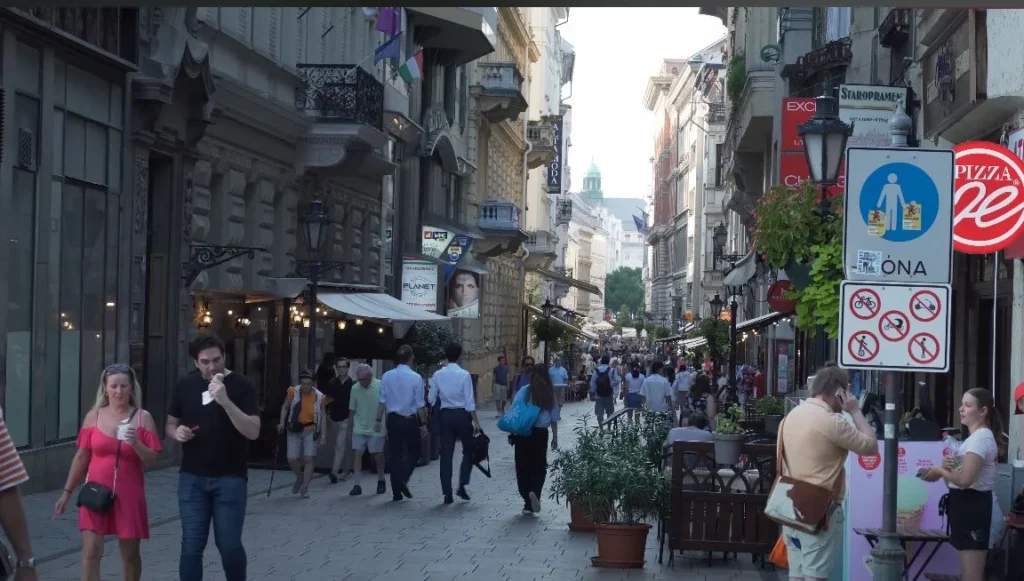
District VIII. Not in your guidebook. Shouldn’t be in mine. But real Budapest lives here, between the crumbling facades and the suspicious looks.
The buildings are dying beautifully. Bullet holes from 1956 still visible if you know where to look. The locals point them out like tour guides, proud of their scars. “Revolution,” they say, like that explains everything. Maybe it does.
There’s this courtyard – won’t tell you exactly where because it doesn’t need tourists – where artists have taken over abandoned apartments. Not official artists. Not gallery artists. Just people making things because the rent is free if you’re willing to live without reliable heating or the guarantee the ceiling won’t collapse.
Met a sculptor there who’d been squatting for three years. His English was perfect – studied at Oxford before deciding academia was “bullshit for people afraid of real life.” Now he makes statues from garbage he finds in the Danube. They’re hideous. They’re beautiful. They’re probably tetanus risks.
The neighborhood is gentrifying fast. Coffee shops appearing like mushrooms after rain. The kind that serve flat whites for 1,400 forint to people with MacBooks writing novels that’ll never be finished. The locals hate it. They also run the coffee shops. Budapest paradox #47.
The Side Trip That Made No Sense (But Neither Does Budapest)
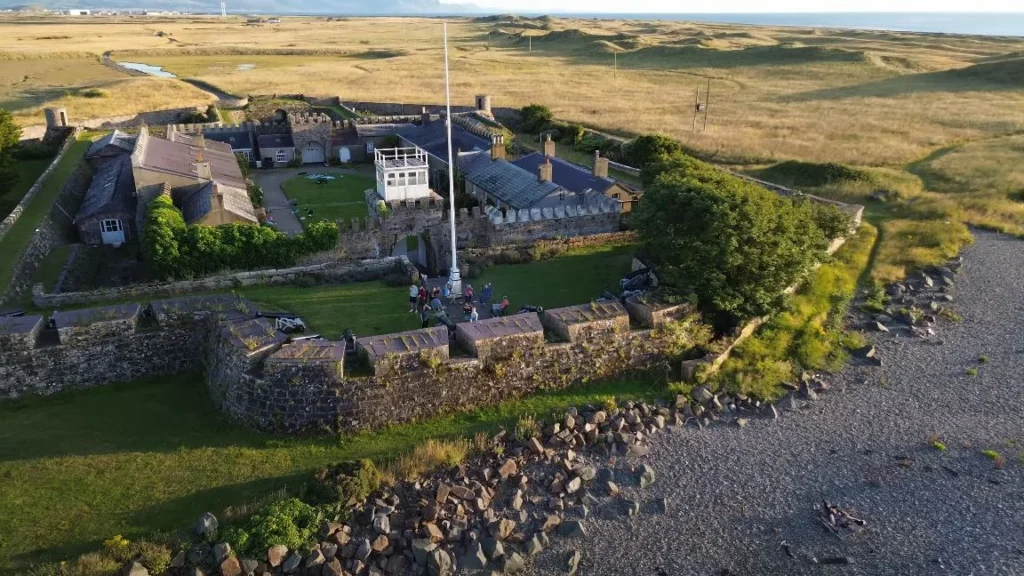
Four days into Budapest, I snapped. The city was too much. Too yellow, too loud, too… Hungarian. So I did what any rational person would do – took a train to absolutely nowhere to stare at ruins by the sea.
Except Hungary is landlocked. So the “sea” was Lake Balaton and the ruins were… actually, I’m still not sure what they were.
The journey there deserves it’s own therapy session. Three trains, two bus transfers and one hitchhike with a farmer who definitely thought I was insane. “Miért?” he kept asking. Why? I didn’t have an answer in English, let alone Hungarian.
The fort – castle? Defensive position? Instagram trap? – sits on this spit of land that feels like the edge of the world. Wind that could peel paint. Grass so aggressively green it hurt to look at. And these stone walls that someone, at some point, decided were worth building in the middle of absolute nowhere.
The entrance fee was 500 forint, collected by a man who looked shocked anyone showed up. He handed me a brochure entirely in Hungarian and pointed vaguely at everything, which was helpful in the way that having no information is sometimes better than wrong information.
I sat on those walls for three hours. Watched the sun do things to the water that photographers would sell their souls for. Ate a sandwich that had somehow survived the journey. Thought about nothing. Everything. Whether that farmer would come back to get me (he didn’t).
The best part? Missing the last bus back. Had to walk 7 kilometers to the nearest town that might have a train station. Might. The station existed, but the next train was at 5:23 AM. Slept on the platform bench using my backpack as the world’s worst pillow. A stray dog kept me company, judging my life choices with the wisdom only Hungarian strays possess.
Worth it? Ask me after therapy.
Transportation Bingo: How Many Ways Can You Almost Die?
The trams. We need to discuss the trams.
They’re not vehicles; they’re suggestions of vehicles. Yellow ones from the communist era that sound like they’re digesting themselves. Newer blue ones that pretend to be modern but give up at the first sign of a hill. All of them driven by people who’ve transcended beyond caring about mortal concerns like “stops” or “schedules.”
The trick is to not expect anything. Tram says it’s coming at 14:23? Could be 14:20. Could be 14:45. Could be never. The electronic boards lie with the confidence of politicians. “2 minutes” means anywhere from thirty seconds to the heat death of the universe.
My favorite was the 4-6 tram along the Danube. It’s basically a tourist trap on rails, but at sunset? When you’re rattling along watching the bridges light up one by one? Magic. Pure, rattling, possibly dangerous magic.
Then there’s the metro. Line M1 is UNESCO protected, which is Hungarian for “so old it’s historically important to keep running despite obvious safety concerns.” Those tiny yellow carriages from 1896 that look like toys. The stations with their original tiles and that smell – hundred-year-old dust mixed with modern despair.
M3 is having a midlife crisis. Half the stations are under renovation simultaneously because efficiency isn’t a Hungarian concept. The escalators are so steep and fast I watched a grandmother literally fly past me, her expression suggesting this was normal.
Night buses are where hope goes to die. The 906 specifically. It theoretically follows a route. In practice, it’s a mobile party for drunk people and those of us too cheap to pay for taxis. The driver had a pet theory about red lights (they’re optional after 2 AM, apparently). A man tried to bring a shopping cart full of watermelons on board. He was allowed. The watermelons rolled everywhere at the first turn. Nobody helped. Everyone watched.
The Restaurant Roulette Chronicles
Found a place called Frici Papa. Sounds cute, right? Papa Frici’s place. What could go wrong?
Everything. But in the best way.
The decor was taxidermy meets communist nostalgia meets someone’s grandmother’s attic. A stuffed boar wearing a Hungarian flag as a cape. Photos of Stalin next to photos of puppies. Lace curtains that had witnessed things.
The menu came in a folder that had definitely been around since the Soviet times. Laminated pages yellow with age and what I hoped was just age. Everything was in Hungarian except for one page that said “TOURIST MENU” in Comic Sans. I obviously ordered from the Hungarian side.
What arrived was a crime against vegetables. Cabbage rolls the size of grenades. Sour cream that had it’s own gravitational pull. Meat that might have been pork, might have been beef, might have been something that was friends with the taxidermied boar.
The waiter – who was also the owner, his own best customer and possibly living there – kept bringing shots of pálinka. “For digestion,” he said, which was optimistic considering pálinka could strip paint. After the third shot, the food started making sense. After the fifth, I was discussing Hungarian poetry with a local despite neither of us speaking the other’s language.
4,800 forint for a meal that tried to kill me, succeeded partially and left me wanting more.
Things That Should Be Illegal But Aren’t
The Parliament Tour Scam
19,000 forint to tour Parliament. NINETEEN THOUSAND. That’s like fifty euros to walk through a building that my taxes (if I paid Hungarian taxes) would theoretically fund.
But everyone says you have to do it. So I did it.
Forty-five minutes of a guide reading from a script older than democracy. “This room has gold.” Yes, I can see that. “This carpet is red.” Revolutionary information. “No photos in this specific room that looks exactly like the other rooms where photos are allowed.” Sure, that makes sense.
The crown jewels are there. Behind glass so thick you can barely see them. Guarded by guys who look like they’d rather be literally anywhere else. The crown is crooked. Has been for centuries. Nobody knows why. “Is character,” the guide said. Everything in Hungary that’s broken is “character.”
The Spa Where Clothes Are Optional And Judgment Is Mandatory
Not Széchenyi. The other one. Rudas. The one tourists skip because it’s “too local.”
Too local means naked old men discussing politics in 42-degree water while their skin turns the color of boiled lobsters. It means no English signs, no helpful staff, no idea which door leads to the changing room and which leads to the sauna where you’ll be yelled at for wearing swimwear.
Made that mistake. Walked into the traditional section fully clothed. The collective gasp could’ve powered Budapest for a week. A man who looked like Gandalf if Gandalf had given up pointed aggressively at a sign I couldn’t read. Another man just laughed. A third offered me his towel, which was kind but also somehow worse.
1,800 forint on weekdays. The sulfur smell gets in your hair and stays for days. You’ll smell like a chemistry experiment gone wrong. Your skin will be baby-soft though. Or it’ll all fall off. Fifty-fifty chance.
The Markets Beyond the Market
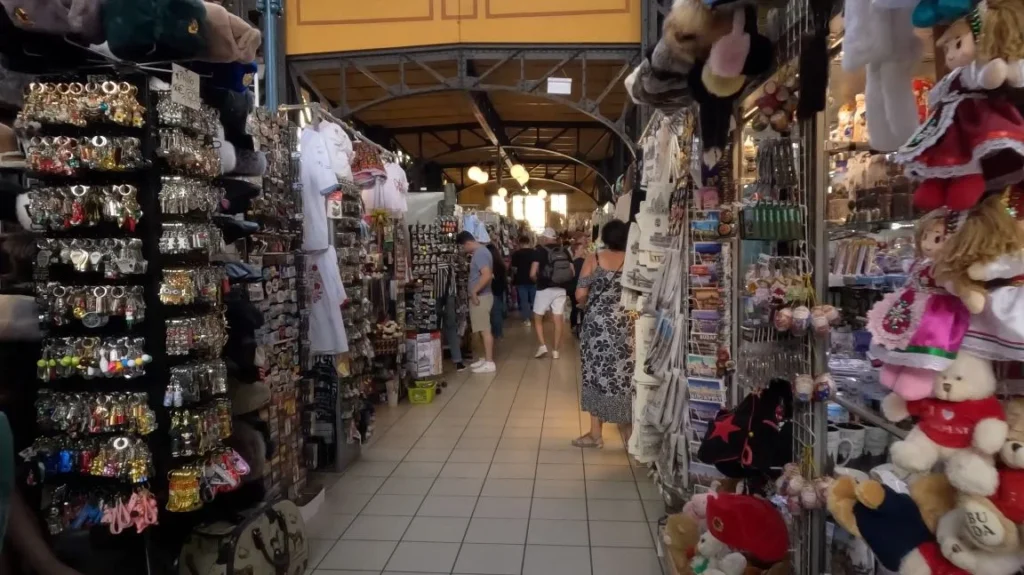
Lehel Market. Where actual humans buy actual food for actual life, not Instagram.
It’s ugly. Aggressively ugly. Concrete and fluorescent lights and vendors who view customers as mild inconveniences. But the produce? Tomatoes that taste like tomatoes instead of disappointing water. Peppers that could make you cry from across the room. Fruit that wasn’t bred for shelf stability but for flavor.
Bought cherries from a woman who insisted on giving me exactly 73 forints change from a 500 forint note. She counted it three times. I tried to wave it off. She looked at me like I’d insulted her ancestors. In Hungary, the correct change is a matter of honor.
The meat section is not for the weak. Things hang that you didn’t know could hang. Parts of animals that you thought were theoretical. A butcher tried to sell me a brain. “Very good, very fresh,” he promised. Fresh from what? When? I bought sausages instead. He looked disappointed in my cowardice.
Váci Utca: A Cautionary Tale
I have to talk about it because you’ll end up there. Everyone does. It’s like Budapest’s tourist flytrap.
Every shop sells the exact same Hungarian “crafts” made in China. Matryoshka dolls because tourists can’t tell the difference between Russia and Hungary. Paprika in decorative bags that cost four times what it costs literally one street over. Restaurants with menus in seventeen languages, none of them Hungarian.
But here’s the thing – at 6 AM, before the tourist tsunami, it’s actually beautiful. The architecture that everyone’s too busy shopping to notice. The details in the stonework. The way the early light hits those windows. I went back three mornings in a row just to see it empty. The street cleaners thought I was insane. “Why here?” one asked in perfect English. Good question.
Met a guy running a currency exchange booth who’d been there since 1991. He’d seen the street transform from local shopping to tourist hell. “More money now,” he shrugged, “less soul.” Then he offered me a terrible exchange rate, because tradition is tradition.
The Sunday Situation
Budapest doesn’t do Sundays. It’s like the entire city collectively decided that God’s day means everything closes except churches and regret.
Woke up at noon (pálinka is not your friend) to find a city in hibernation. Shops? Closed. Restaurants? Mostly closed. That café you loved? Definitely closed. Even some of the tourist traps take Sundays off, which is oddly respectful.
The only things functioning are:
- Churches (obviously)
- Thermal baths (because Hungarians would riot)
- Ruin bars (because alcohol is a human right)
- That one Vietnamese restaurant that doesn’t care about your Christian God
Ended up at the Vietnamese place with about thirty other confused tourists and locals who forgot to shop on Saturday. The pho was actually incredible. Better than anything I had in Vietnam, though that might have been the hangover talking. The owner, a tiny woman who’d been in Budapest since 1989, told me about watching the Wall fall while serving spring rolls. “Communists, capitalists,” she shrugged, “everyone needs noodles.”
The Language Barrier Olympics
When Pointing Fails
Hungarian isn’t a language. It’s revenge for something, I’m not sure what.
44 letters in their alphabet. FORTY-FOUR. Some of them are actually two letters pretending to be one, like “sz” and “gy” and “dzs” which is apparently a single letter that sounds like you’re sneezing. The word for “hello” – szia – is pronounced “see-ya” which sounds like goodbye in English because Hungary enjoys chaos.
Tried to learn basics. “Köszönöm” for thank you. Except it’s not ko-sho-nom like it looks. It’s something like “kur-sur-nurm” but with your tongue doing gymnastics. The ticket lady at Keleti station actually winced when I attempted it. Physically winced.
My lowest point? Trying to buy hemorrhoid cream. Don’t judge – those wooden metro seats are unforgiving. Spent twenty minutes in a pharmacy playing the world’s worst charades. The pharmacist, dead-faced, finally just started pulling out every cream they had. Anti-fungal? No. Antibiotic? Head shake. When we finally got there, she said in perfect English, “You could have just asked.”
She knew English THE ENTIRE TIME.
Restaurant Russian Roulette, Language Edition
Ordered “pacal” once because it was the cheapest thing on the menu. 2,400 forint? Bargain.
It’s tripe soup.
Cow stomach lining floating in paprika broth like jellyfish from hell. The waiter watched me take the first bite with the intensity of a scientist observing a lab rat. I managed three spoonfuls before my body staged a revolt.
“Is traditional!” he said cheerfully, in suddenly-perfect English. “My grandmother makes better.”
Better? This was the inferior version?
He brought me bread and watched me eat the entire basket. Then charged me 800 forint for it. “Bread not free in Hungary,” he explained. Nothing is free in Hungary. Not even suffering, apparently.
The Final 48 Hours: Everything Goes Wrong Right
The Wallet Incident
Day 8. Woke up to discover my wallet had gone on it’s own adventure. Last seen at that ruin bar where I definitely didn’t have seven shots of pálinka. Definitely.
The panic. That specific tourist panic where you’re calculating: cancel cards? Embassy? Sell a kidney?
Went back to Szimpla. Closed. Of course. Opens at noon because morning people don’t deserve ruin bars. Sat outside for three hours watching the door like a stalker. A homeless guy joined me. We didn’t share a language but we shared the bench and the existential crisis.
Noon. Doors open. The bartender – different one, but they all have that same dead-eyed wisdom – hands me my wallet before I even ask. Everything still inside. Including a note: “You dance like a fish. -Petra”
I don’t remember Petra. I don’t remember dancing. The fish comparison feels accurate though.
The Last Supper (That Wasn’t)
Final night. Wanted something special. Found a restaurant with a Michelin recommendation (not a star, just a recommendation, which is like saying “we noticed you exist”).
8,000 forint for the tasting menu. Five courses of confusion.
Course 1: Foam. Literal foam. Tasted like paprika had an anxiety attack.
Course 2: One piece of duck the size of a coin. Sitting in sauce that was more concept than food.
Course 3: “Deconstructed goulash.” It was three drops of different colored liquids and a crouton. My grandmother would have started a revolution.
Course 4: Fish from Lake Balaton. Actually good. Suspiciously good. So good I wondered if the previous courses were just hazing.
Course 5: Dessert that looked like modern art and tasted like sweetened confusion. Came with a tiny glass of Tokaji wine that cost more than my hostel.
Left hungry. Ended up at a non-stop gyros place at 1 AM where a Turkish guy who’d lived in Budapest for twenty years gave me life advice while overloading my wrap with meat. “Budapest,” he said, “is like this gyros. Too much, falling apart, probably bad for you, but you keep eating.”
3,000 forint for wisdom and heartburn. Better than the Michelin place.
The Airport Goodbye

The 100E airport bus. Budapest’s last chance to confuse you.
Supposedly “direct” to the airport. Makes seventeen stops that aren’t stops. “Technical pauses,” the driver called them. Technical pauses to test your blood pressure as departure time approaches.
A German tourist was in full meltdown. “In Germany, direct means direct!” He kept saying this like it would change something. His wife had that thousand-yard stare of someone who’d been married to a German for too long.
The bus driver, magnificent in his indifference, smoked a cigarette at one of these “technical pauses.” The entire bus watching. Nobody said anything. You don’t mess with Hungarian bus drivers. They’ve transcended beyond customer service into something approaching performance art.
Made my flight with twelve minutes to spare. The security guy found the paprika collection in my bag and laughed. “Every tourist,” he said. “Every single one.”
Then he confiscated my water bottle that I’d bought INSIDE security. “Different security zone,” he explained. Budapest’s final magic trick.
What I Actually Learned
The Numbers Game
- Days in Budapest: 9
- Forints spent: 287,000 (about €700)
- Thermal baths visited: 4
- Times lost: 47
- Correct pronunciation achieved: 0
- Shots of pálinka: Classified
- Kilos gained: 4
- Regrets: 0
The Real Cost
Transport card: 9,500 forint Unexpected bread charges: 2,400 forint Tourist trap chimney cake: 2,800 forint Watching a city that shouldn’t exist thrive anyway: Priceless (but actually about 287,000 forint)
Things Nobody Tells You
- Budapest hates you but in a loving way. Every inconvenience feels personal but also like initiation. You’re not a tourist; you’re a contestant in an elaborate hazing ritual called “vacation.”
- The ATMs are plotting something. They all work differently. Some want your PIN first. Some want it last. Some want you to suffer. They’re definitely communicating with each other.
- Everything important happens underground. The best bars: basements. The real markets: basements. The metro: obviously underground. Budapest is basically an iceberg city – the good stuff is hidden below.
- Hungarians complain about everything but won’t change anything. The weather, the government, the traffic, the tourists. But suggest improvements? “This is how it is.” And honestly? They’re right.
- You will never understand the tipping system. 10%? 15%? Round up? Leave coins? Every Hungarian has a different answer. I just started leaving 10% everywhere and hoping for the best. Sometimes they seemed insulted. Sometimes grateful. Sometimes confused. There’s no winning.
The Truth About Budapest
It’s not beautiful like Paris. It’s beautiful like a boxer who keeps getting up – scarred, stubborn, magnificent in it’s refusal to be anything other than exactly what it is.
The city doesn’t want your love. Doesn’t need your Instagram validation. It exists in spite of tourism, not because of it. Every beautiful building is beautiful by accident or spite or because someone forgot to tear it down. Every thermal bath is there because Hungarians need their hot water therapy, not because you need a spa day. Every restaurant that matters is hidden because locals don’t want you to find it.
But if you can handle being consistently uncomfortable, constantly confused and occasionally convinced you’re being personally victimized by an entire city, something clicks. Usually around day 4. Usually after too much pálinka. Usually when you’re lost again but realize you don’t actually care.
Budapest isn’t a vacation. It’s a test. And passing doesn’t mean understanding it. Passing means accepting you never will.
Would I go back?
I’m already checking flights.

